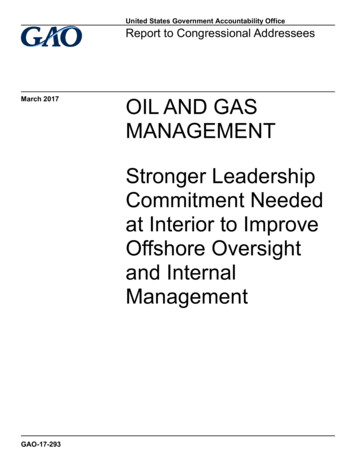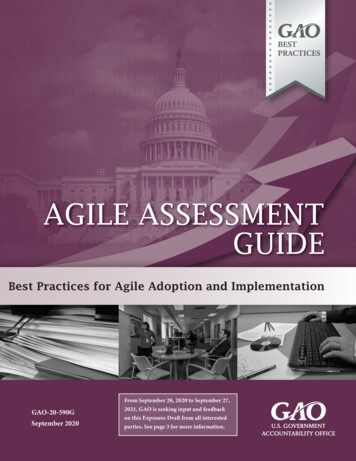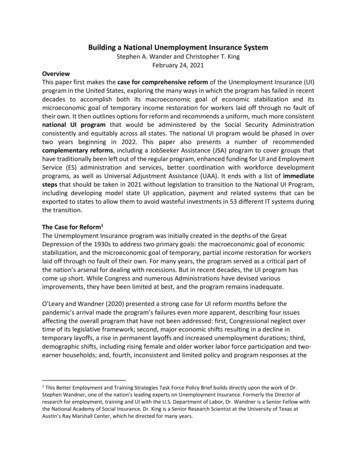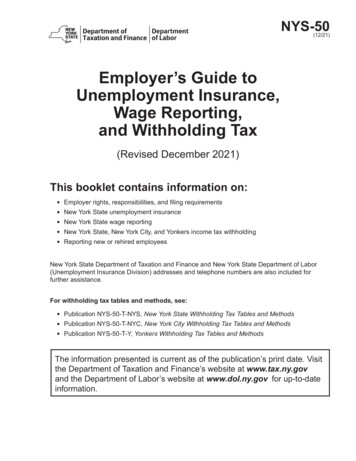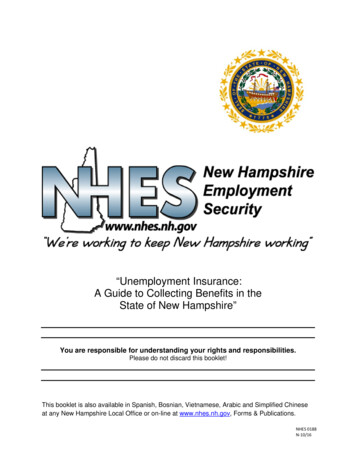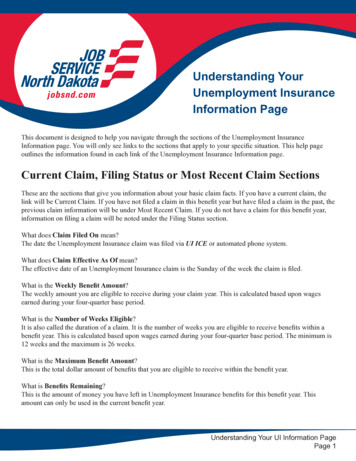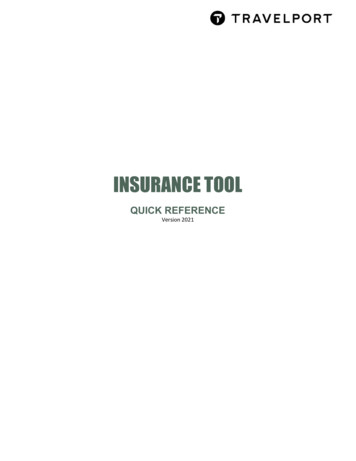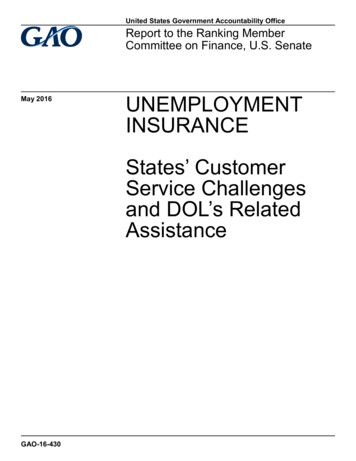
Transcription
United States Government Accountability OfficeReport to the Ranking MemberCommittee on Finance, U.S. SenateMay 2016UNEMPLOYMENTINSURANCEStates’ CustomerService Challengesand DOL’s RelatedAssistanceGAO-16-430
May 2016UNEMPLOYMENT INSURANCEStates' Customer Service Challenges and DOL'sRelated AssistanceHighlights of GAO-16-430, a report to theRanking Member, Committee on Finance,U.S. SenateWhy GAO Did This StudyWhat GAO FoundUI benefits are a critical source ofincome for millions of unemployedAmericans. Overseen federally by DOLand administered by states, the UIprogram requested 32.5 billion inbenefits in fiscal year 2015 forapproximately 7 million UI claims.During the 2007-2009 recession,states faced challenges processingrecord numbers of claims, andquestions were raised about the qualityof customer service. GAO was askedto review customer service issues instate UI programs.In GAO focus groups of recent claimants filing for unemployment insurance (UI)benefits, those who filed by phone reported experiencing various challenges,such as long call wait times; however, those filing for benefits online reported thatit was generally easy to do. In all six of the focus groups GAO conducted in thethree states it visited, individuals who had claimed benefits by phone betweenJuly 2014 and July 2015 reported experiencing challenges with the state UIprogram’s customer service. GAO defined customer service as including ease ofprogram access, courtesy, timeliness, and accuracy, as well as responsivenessto customer needs and expectations. Some participants in all six focus groupsreported experiencing long call wait times and difficulties using automated phonesystems. In addition, in two of the states visited, representatives of advocacygroups reported that special populations, including individuals with limitedEnglish proficiency, had difficulty accessing the UI program. In GAO’s survey ofstate UI programs, most states—including those GAO visited— reportedcollecting some data on customer service challenges for claimants. For example,38 states reported collecting data on average call wait times.GAO examined (1) customer servicechallenges, if any, recent UI claimantshave faced and the extent to whichstates collect information on claimants’challenges, (2) any challenges stateshave faced providing customer serviceto claimants, and any improvementsthey have made, and (3) the extent towhich DOL monitors states’ customerservice efforts and provides assistanceto help them make improvements.GAO surveyed state UI programs in 50states and the District of Columbia(with 48 responding); interviewedofficials from state UI programs andadvocacy groups in California, NewYork, and Texas (selected forgeographical diversity and largenumbers of UI claims); and conductedsix focus groups with recent UIclaimants in these three states. Focusgroup results are not generalizable, butprovide important insights into theexperiences of some UI claimants.GAO also reviewed relevant federallaws and DOL guidance.What GAO RecommendsGAO is not making recommendationsin this report.Many states reported challenges in providing customer service, including staffingissues, and most have taken some steps to improve customer service, such asincreasing self-service options. Specifically, more than half the states GAOsurveyed reported insufficient staffing, outdated Information Technology (IT)systems, and funding constraints, all of which could play a role in claimantchallenges. Many states also reported that they have taken or are planning totake some actions to improve customer service. For example, 45 states reportedtaking action to provide self-service options, and 42 states reported taking actionto provide customer service training to program representatives.The Department of Labor’s (DOL) Employment and Training Administration(ETA) provides states with monitoring and assistance on some aspects ofcustomer service. ETA monitors and measures state performance on thetimeliness of benefit payments and appeals decisions. ETA also monitors andmeasures the accuracy of states’ non-monetary eligibility determinations, such aswhether states accurately assess reasons for claimants’ separation fromemployment. In addition, ETA provides states with various technical assistance.ETA has provided states with assistance on IT modernization, staffing issues,and program access for special populations. UI program officials in the threestates GAO visited said they could benefit from more information on other states’successful customer service practices, including practices for addressingcontinuing staffing and IT challenges. ETA plans to share these practices on anongoing basis, officials said. For example, officials said ETA plans to sharesuccessful practices—including those related to staffing—obtained from itsnational study of call center operations through its online community of practice.ETA also plans to continue to collect lessons learned from state IT systemmodernization efforts and disseminate them to states.View GAO-16-430. For more information,contact Cindy Brown Barnes at (202) 5127215 or brownbarnesc@gao.gov.United States Government Accountability Office
ContentsLetter1BackgroundClaimants Faced Challenges Filing Claims by Phone andAccessing Services in Other Languages, and Most StatesCollect Some Information on Claimant ChallengesMany States Reported Facing Challenges, and Most Have TakenSome Steps to Improve Customer Service, Such as IncreasingSelf-ServiceDOL Provides States with Monitoring and Assistance on SomeAspects of Customer Service, and Has Taken Steps to ShareSuccessful State PracticesAgency Comments2530Appendix IObjectives, Scope, and Methodology31Appendix IIUnemployment Insurance (UI) Performance Measures andAcceptable Levels of Performance37GAO Contact and Staff Acknowledgments39Appendix IIIRelated GAO Products381440TablesTable 1: Customer Service Data Collected by States onUnemployment Insurance Claims Filed by PhoneTable 2: Core Unemployment Insurance (UI) ProgramPerformance Measures That Directly Address CustomerService IssuesPage i1326GAO-16-430 Unemployment Insurance
FiguresFigure 1: General Overview of the Process for FilingUnemployment Insurance (UI) ClaimsFigure 2: Staffing Challenges Reported by State UnemploymentInsurance (UI) Programs, During Last 12 Months andDuring RecessionFigure 3: Challenges Related to Limitations of State InformationTechnology (IT) Systems Reported by StateUnemployment Insurance Programs (UI), During Last 12Months and During RecessionFigure 4: Challenges Related to Federal Administrative FundingConstraints Reported by State Unemployment Insurance(UI) Programs, During Last 12 Months and DuringRecessionFigure 5: Challenges Related to Claims Filed by Phone Reportedby State Unemployment Insurance (UI) Programs, DuringLast 12 Months and During RecessionFigure 6: Practices to Improve Customer Service Reported byState Unemployment Insurance (UI) MBOUIUIDepartment of LaborEmployment and Training AdministrationInformation TechnologyInformation Technology Support CenterNational Association of State Workforce AgenciesOffice of Management and BudgetOffice of Unemployment InsuranceUnemployment InsuranceThis is a work of the U.S. government and is not subject to copyright protection in theUnited States. The published product may be reproduced and distributed in its entiretywithout further permission from GAO. However, because this work may containcopyrighted images or other material, permission from the copyright holder may benecessary if you wish to reproduce this material separately.Page iiGAO-16-430 Unemployment Insurance
Letter441 G St. N.W.Washington, DC 20548May 12, 2016The Honorable Ron WydenRanking MemberCommittee on FinanceUnited States SenateDear Senator Wyden:Unemployment insurance (UI) benefits serve as a critical source ofincome for millions of unemployed Americans. The UI program is afederal-state partnership established by the Social Security Act in 1935 toprovide temporary financial assistance to those who become unemployedthrough no fault of their own and to help stabilize the economy duringrecessions. According to officials from the Department of Labor (DOL), infiscal year 2015 the agency requested 32.5 billion in benefits for 6.7million UI claims. The UI program is administered by the states, andDOL’s Employment and Training Administration (ETA) oversees states’compliance with broad federal requirements, which include that statesmust have methods of administration that ensure full payment ofunemployment benefits when due.During the recession that began in 2007, state UI programs facedchallenges processing record numbers of claims, and questions wereraised about the quality of customer service provided to claimants. 1 At thepeak of the recession in calendar year 2009, according to DOL, statesprocessed over 17.5 million new initial UI claims. 2 By calendar year 2015,the number of these claims had dropped to approximately 9.2 million. Youasked us to review customer service challenges faced by UI claimantsand state UI programs.This report examines (1) the customer service challenges, if any, recentUI claimants have faced and the extent to which states collect information1The National Bureau of Economic Research defines the economic recession as occurringfrom December 2007 to June 2009.2A new initial claim is the first claim filed to determine whether or not a claimant is eligiblefor UI benefits.Page 1GAO-16-430 Unemployment Insurance
on claimants’ challenges, (2) any challenges states have faced inproviding customer service to UI claimants, and any improvements theyhave made, and (3) the extent to which DOL monitors states’ customerservice efforts and provides assistance to help them make improvements.For the purposes of our study, we defined customer service as theservice that state UI programs provide to claimants, including those whoare eligible and those who are ineligible for benefits. This includes, but isnot limited to, ease of program access, courtesy, timeliness, andaccuracy, as well as responsiveness to customer needs andexpectations.To examine the customer service challenges recent UI claimants havefaced, we conducted six focus groups with UI claimants in California, NewYork, and Texas who applied for UI benefits between July 2014 and July2015, using a contractor to recruit and screen participants. We selectedthis time period to identify participants who had applied for benefits withinthe 12 months preceding the award of the contract. Focus groups wereheld in September 2015. We also conducted site visits in these states,which were selected for their geographic diversity and size based on thenumber of new initial UI claims in calendar year 2014, the most recentyear for which data were available. We asked focus group participantsabout their experiences with customer service in their state UI programs,including any challenges they faced. Focus group results are notgeneralizable within states or nationwide, however, they provideimportant insights into the experiences of some UI claimants. We alsoidentified and interviewed representatives of advocacy groups in our sitevisit states to discuss their views on the challenges experienced by UIclaimants in those states. In part, we selected these groups to provideperspectives on the challenges faced by claimants with limited Englishproficiency and claimants with disabilities who were not specificallyselected for our focus groups. 3 The opinions expressed by these groupsrepresent their points of view, and may not represent the views of alladvocacy groups or the customer service experiences of all claimantswith limited English proficiency and claimants with disabilities.To address all three objectives, we conducted a web-based survey of UIprograms in all 50 states and the District of Columbia about the customer3We did not assess state compliance with statutory and regulatory program access andnondiscrimination requirements.Page 2GAO-16-430 Unemployment Insurance
service data they collect, the customer service challenges they havefaced, practices they have implemented to improve customer service, andcustomer service assistance they have received from DOL. A total of 48states responded to our survey, representing a 94 percent response rate.In our site visits to California, New York, and Texas, we interviewed UIprogram officials about their approach to customer service, any customerservice challenges they have faced, and practices they have implementedto improve customer service. 4 We also interviewed various stakeholders,including national associations and officials from DOL, about their role inmonitoring and helping to improve customer service in state UI programs.In addition, we reviewed relevant federal laws, regulations, and guidance.We did not assess state compliance with statutory and regulatoryprogram access and nondiscrimination requirements. (For moreinformation on our objectives, scope, and methodology, please seeappendix I.)We conducted this performance audit from November 2014 to May 2016in accordance with generally accepted government auditing standards.Those standards require that we plan and perform the audit to obtainsufficient, appropriate evidence to provide a reasonable basis for ourfindings and conclusions based on our audit objectives. We believe thatthe evidence obtained provides a reasonable basis for our findings andconclusions based on our audit objectives.BackgroundUI Program Administrationand OversightAs a federal-state partnership, the framework for the UI program isestablished by federal law, which sets broad requirements that stateprograms must follow, including categories of workers that must becovered by the program. While states design and administer their ownprograms, DOL’s Employment and Training Administration (ETA) isresponsible for ensuring that state UI laws conform to, and state programoperations comply with, federal law. For example, as required by theSocial Security Act, 5 ETA is to ensure state laws include provisions thatallow for full payment of UI benefits when they are due. ETA also sets4In addition, we conducted interviews with the UI programs in Illinois and Pennsylvania.542 U.S.C. § 503(a)(1).Page 3GAO-16-430 Unemployment Insurance
overall program policy, monitors state performance, and provides stateswith technical assistance. For example, ETA sets acceptable levels ofperformance and monitors states on measures related to benefits,program integrity, appeals, tax, and reemployment (see appendix II). ETAoversees state UI programs through its Office of UnemploymentInsurance (OUI) and its six regional offices. The regional offices are thestates’ main points of contact with DOL and serve as a link between thedepartment and the states for providing technical assistance andclarifying program policies, objectives, and priorities.State UI Programs, ClaimsProcesses, and BenefitsWhile federal law sets forth broad provisions for the categories of workersthat must be covered by the program, some benefit provisions, andcertain administrative requirements, the specifics of regular UI benefitsare determined by each state and the District of Columbia. This results inessentially 51 different programs. 6 States administer their own programsand have considerable flexibility to set benefit amounts and their duration,and establish eligibility requirements and other program details. Statesare also responsible for customer service in their UI programs. For ageneral overview of the process for filing UI claims, see fig. 1.6We did not include UI programs in Puerto Rico and the U.S. Virgin Islands in our review.Page 4GAO-16-430 Unemployment Insurance
Figure 1: General Overview of the Process for Filing Unemployment Insurance (UI) ClaimsNote: The methods available for filing claims vary across states.aA new initial claim is the first claim filed to determine whether or not a claimant is eligible for UIbenefits.bIn most states, calls to state UI programs are directed to call centers, where either programrepresentatives, automated telephone systems, or a combination of both respond.Typically, eligible unemployed workers can receive UI benefits for up to26 weeks in most states. In addition to state UI benefits, the FederalState Extended Benefit Program provides additional weeks of benefitsduring high and rising unemployment.UI Program FundingUI programs are generally funded by federal and state payroll taxeslevied on employers. State benefits for unemployed workers are primarilyfinanced by state employer payroll taxes and are placed in a trust fundthat the federal government maintains on behalf of states. Ideally, statesbuild reserves in their trust fund accounts through revenue from employerPage 5GAO-16-430 Unemployment Insurance
taxes during periods of economic expansion in order to pay UI benefitsduring economic downturns. Federal taxes paid by employers are used tofund the costs of administering UI programs in all states, among otherpurposes.As part of the President’s Budget, DOL uses a combination of nationalclaims-related workload projections and other factors to develop therequest for UI administrative funding for states. After Congressappropriates funds, DOL uses a formula to allocate the funding to statesand considers state workloads estimates, as well as other informationprovided by states, such as cost accounting information. Since funding iscalculated in part based on claims-related workloads, the federal fundingavailable to states is generally sensitive to changes in total claims, withmore funding available when claims increase and less when theydecrease. States may also receive additional federal administrativefunding above base levels on a quarterly basis when claims-relatedworkloads exceed base funding levels. ETA may also awardsupplemental funds to states for special UI projects, such as supportingstate efforts to reduce improper payments. In addition, states may provideadditional state funding for the administration of their UI programs.UI Information TechnologyModernizationState UI programs rely extensively on Information Technology (IT)systems to carry out their UI program functions. Specifically, IT systemsare used to administer the programs and to support related administrativeneeds. For example, these systems are used to support benefit eligibilitydeterminations, record claimant filing information, and calculate benefitamounts.The majority of the states’ existing systems for UI operations were,however, developed in the 1970s and 1980s, and we previously reportedthat states face challenges modernizing these legacy systems to operatemore efficiently. 7 These challenges included limited staff with thetechnical and project management expertise to manage systemmodernization efforts, limited funding for modernization efforts, andlimited resources for operating legacy systems while implementingmodernized systems.7GAO, Information Technology: Department of Labor Could Further FacilitateModernization of States’ Unemployment Insurance Systems, GAO-12-957 (Washington,D.C.: Sept. 26, 2012).Page 6GAO-16-430 Unemployment Insurance
Customer ServicePractices and StandardsIn recognition of the importance of service delivery in effectivegovernance, in April 2011 the White House issued Executive Order13571—Streamlining Service Delivery and Improving Customer Service—which required federal agencies to, among other things, work with theOffice of Management and Budget (OMB) to develop a customer serviceplan for federally-administered programs, establish mechanisms to solicitcustomer feedback, and improve customer service by adopting bestpractices. 8 Agencies’ plans were required to address approximately threeto five of their highest volume services. In response, DOL developed acustomer service plan which includes workers in federal contracting,worker safety and health, and worker rights; however, it does not coverthe UI program because it is administered by states. According to DOLofficials, while agencies were not required to update their plans and DOLhas not done so, a committee report accompanying the ConsolidatedAppropriations Act, 2016, directed OMB to report in March 2016 onagencies’ progress in developing customer service standards andincorporating them into their performance plans. 9In a 2010 report on federal agency customer service standards, weidentified several examples of quality customer service, includingunderstanding customers’ needs and organizing services around thoseneeds, offering self-service options, and providing citizens with theinformation necessary to hold government accountable for customerservice performance. 10 In 2014, we reviewed customer service standardsfor federally-administered programs at five federal agencies and foundthat none of the agencies’ standards included all the key elements ofcustomer service standards, such as performance targets or goals andperformance measures. 118Exec. Order No. 13571 (Apr. 27, 2011), Streamlining Service Delivery and ImprovingCustomer Service, 76 Fed. Reg. 24,339 (May 2, 2011).9Pub. L. No. 114-113, 129 Stat. 2242 (2015).10GAO, Managing for Results: Opportunities to Strengthen Agencies’ Customer ServiceEfforts, GAO-11-44 (Washington, D.C.: Oct. 27, 2010).11Specifically, we reviewed customer service standards at Customs and BorderProtection, the Forest Service, Federal Student Aid, the National Park Service, and theVeterans Benefits Administration. GAO, Managing for Results: Selected Agencies Need toTake Additional Efforts to Improve Customer Service, GAO-15-84 (Washington, D.C.: Oct.24, 2014).Page 7GAO-16-430 Unemployment Insurance
Claimants FacedChallenges FilingClaims by Phone andAccessing Services inOther Languages,and Most StatesCollect SomeInformation onClaimant ChallengesClaimants in Our FocusGroups ReportedExperiencing Long CallWait Times and DifficultyUsing Automated PhoneSystemsClaimant Quote“It’s pretty much been the same, the sameproblems as in 2009 when I first applied,specifically, the wait times, trying to get a holdof someone taking so long. I usually am onthe phone for 20, 30 minutes, get frustrated,hang up, call back another day.”In all six of the focus groups we conducted in California, New York, andTexas, claimants reported experiencing long call wait times or having tocall multiple times before reaching program representatives to file claimsor ask questions. 12 Across all six focus groups, claimants reported callwait times ranging from about 20 minutes to 2 hours. 13 Also, in one statewith limited call center hours, claimants told us they waited on hold orcalled repeatedly for up to 4 hours before reaching a representative.Across all six groups, claimants described long wait times as beingfrustrating or inconvenient, and in three groups, claimants believed thesewait times resulted from a lack of sufficient state UI program staff. Inaddition, claimants in five of six groups said they called multiple times—Source: GAO’s focus groups with unemployment insuranceclaimants. GAO-16-430.12Focus group findings cannot be generalized within states or nationwide.13Focus group participants reported a range of call wait times that they considered to belengthy; we did not define a long call wait time as a certain number of minutes.Page 8GAO-16-430 Unemployment Insurance
Claimant Quote“So then I call them on Monday, but I can’t getthrough until Wednesday or Thursday orFriday or sometimes the whole week.”Source: GAO’s focus groups with unemployment insuranceclaimants. GAO-16-430.Claimant Quote“So you’ve already got three prompts beforeyou even get to one that will allow you to askquestions. And then that prompt has two orthree prompts. So you probably go through sixbefore you get to a line that says we have aheavy volume and we can’t service you nowand click.”Source: GAO’s focus groups with unemployment insuranceclaimants. GAO-16-430Claimant Quote“I haven’t actually had anyone that has beenmean. I have spoken to people that werestressed and overworked, but for the mostpart they were as helpful and kind as theycould be under the circumstances that theyhad to work with. Especially when I was fallingapart.”Source: GAO’s focus groups with unemployment insuranceclaimants. GAO-16-430sometimes over days or weeks—before reaching a representative, or saidit took several days for a representative to call them back or respond totheir email messages. For example, claimants told us that when theymissed a call from a representative, it was difficult to reach them to returnthe call. One claimant reported making 15 attempts to leave a messagebecause a representative’s voice mailbox was full.In all six focus groups, claimants told us they had difficulty usingautomated phone systems, and in five groups, claimants said they wereunable to reach program representatives by phone. Claimants said theyhad difficulty using automated phone systems because phone menuswere long and complex, involving numerous steps, or because it waseasy to make mistakes and difficult to fix them. For example, claimantstold us that if they selected the wrong option from the menu, they wereforced to start over. One claimant said it took 40 minutes to file a claimafter accidentally pressing the wrong button. In other examples, claimantstold us they had to hang up—or the system ended the call—after theyreached a “dead end” and were unable to return to the previous menu. Inaddition, in five groups, claimants told us they were unable to reachprogram representatives by phone. For example, claimants said thatwhen they called to file a claim, they received a message indicating thatthe phone system was at full capacity and could not accept additionalcalls. 14When claimants were able to reach program representatives by phone,they reported mixed experiences with their helpfulness and courtesy. Infive of six focus groups, some claimants told us the representatives theyspoke to were helpful and able to answer their questions, while otherssaid they were not helpful or able to answer questions. For example,some claimants noted that representatives identified and correctedmistakes that otherwise would have reduced their benefit amounts, and14After unsuccessful attempts to file using their personal phones, some of these claimantstold us they were able to successfully file claims using a private, dedicated phone line atan American Job Center. American Job Centers—formerly known as one-stop centers—offer employment and training services for jobseekers in a single location.Page 9GAO-16-430 Unemployment Insurance
Claimant Quote“I would say maybe 70 percent of the time it’ssomebody that is new and I feel like I ameducating them.”Source: GAO’s focus groups with unemployment insuranceclaimants. GAO-16-430Claimant Quote“I felt like it was easy. I just found the websiteand put in pretty basic stuff and it pulled up allmy employers that I have had and theearnings and everything was already in there-I didn’t have to enter any of that. Theyalready knew. And then I got the stuff in themail a few weeks later, pretty quick.”Source: GAO’s focus groups with unemployment insuranceclaimants. GAO-16-430Claimant Quote“The online works well. The amount ofinformation, if you actually spend the time tolook through all of the information, it answersmany more questions than they would havetime for on the phone.”Source: GAO’s focus groups with unemployment insuranceclaimants. GAO-16-430one claimant said a representative gave helpful advice about the best dayof the week to file a claim. However, other claimants said representativesseemed to lack knowledge or training, or that different representativesprovided conflicting information. Also, in four of six groups, someclaimants said representatives were courteous, while others said theywere not.In contrast, in all six focus groups, claimants who filed their claims onlinesaid it was generally easy to do so, though they occasionally experiencedsystem disruptions. For example, claimants described the Internet filingprocess as “quick,” “user-friendly,” and “convenient,” and said they foundcertain features helpful, such as the ability to view their past and futurebenefit payments and print out information about their claims. In addition,claimants said they preferred filing online to filing by phone because itwas faster, or because they were less likely to make mistakes. Lessfrequently, claimants in five groups told us that they experiencedchallenges filing online. For example, claimants said that some state UIprogram websites only accepted claims during business hours or weretemporarily unavailable due to system outages. 15In all six focus groups, claimants had mixed opinions about the sufficiencyof the information provided by their state UI programs. For example, in allsix groups, some claimants reported that the state UI program website orwritten program materials provided answers to their questions—such asnext steps in the application process, or the amount of their benefitpayment and when they could expect to receive it. However, othersreported that the UI program website or written materials did not answertheir questions—such as how to calculate their quarterly wages, or whatactivities qualify as “work.” In five of six groups, claimants reported thatthese sources did not provide answers to questions about their unique orcomplex situations, such as how medical leave or severance pay affectedtheir claims, or how to report income from multiple jobs.15Claimants mentioned 11 times that they experienced challenges filing claims online, andmentioned 63 times that it was generally easy to file claims online.Page 10GAO-16-430 Unemployment Insurance
Advocates ReportedIndividuals with LimitedEnglish Proficiency andOther Special PopulationsHave Had DifficultyAccessing the ProgramIn addition to the challenges reported by rec
Page 1 GAO-16-430 Unemployment Insurance . 441 G St. N.W. Washington, DC 20548 May 12, 2016 . The Ho

